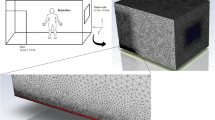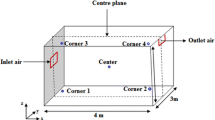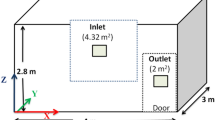Abstract
Computational fluid dynamics (CFD) has been used to simulate the distribution of indoor radon concentration in a naturally ventilated room. Finite volume method was employed in CFD code for the simulation of indoor radon. The simulation results were validated at 34 points in a matrix of two horizontal planes (y = 1.3 m and y = 2.1 m) using passive pinhole dosimeters and at six points using an active scintillation radon monitor. The CFD results were found to exhibit an excellent correlation with the measured values. It is concluded that CFD analysis is a powerful tool to visualize indoor radon distribution.






Similar content being viewed by others
References
Ackers JG (1984) Direct measurement of radon exhalation from surfaces. Radiat Prot Dosim 7:192–201
Akbari K, Mahmoudi J, Ghanbari M (2013) Influence of indoor air conditions on radon concentration in a detached house. J Environ Radioact 116:166–173
Chauhan N, Chauhan RP (2015) Active–passive measurements and CFD based modelling for indoor radon dispersion study. J Environ Radioact 144:57–61
Chauhan N, Chauhan RP, Joshi M, Agarwal TK, Aggarwal P, Sahoo BK (2014) Study of indoor radon distribution using measurements and CFD modeling. J Environ Radioact 136:105–111
Chen J, Rahman NM, Abu-Atiya I (2010) Radon exhalation from building materials for decorative use. J Environ Radioact 101(4):317–322
Gaware JJ, Sahoo BK, Sapra BK, Mayya YS (2011) Indigenous development and networking of online radon monitors in the underground uranium mine. Radiat Prot Environ 34:37–40
https://www.ansys.com/products/fluids/ansys-fluent. Accessed 07 Feb 2017
Keller G, Hoffmann B, Feigenspan T (2001) Radon permeability and radon exhalation of building materials. Sci Total Environ 272:85–89
Kumar A, Chauhan RP, Joshi M, Sahoo BK (2014) Modeling of indoor radon concentration from radon exhalation rates of building materials and validation through measurements. J Environ Radioact 127:50–55
Maged AF, Ashraf FA (2005) Radon exhalation rate of some building materials used in Egypt. Environ Geochem Health 27(5–6):485–489
Mahur AK, Kumar R, Mishra M, Sengupta D, Prasad R (2008) An investigation of radon exhalation rate and estimation of radiation doses in coal and fly ash samples. Appl Radiat Isot 66(3):401–406
Petropoulos NP, Anagnostakis MJ, Simopoulos SE (2001) Building materials radon exhalation rate: ERRICCA intercomparison exercise results. Sci Total Environ 272:109–118
Porstendorfer J, Wicke A, Schraub A (1978) A influence of exhalation, ventilation and deposition processes upon the concentrations of radon, thoron and their decay products in room air. Health Phys 34:465–473
Reshma B, Ravikumar CD, Visnuprasad AK, Jojo PJ, Dhanalakshmi B, Chitra N, Bala SS, Jose MT, Rosaline M (2017) Inhalation dose and source term studies in a tribal area of Wayanad, Kerala, India. J Environ Public Health 2017:1–10. https://doi.org/10.1155/2017/1930787
Rout RP, Mishra R, Prajith R, Jalaluddin S, Sapra BK (2014) Measurement of 222Rn and 220Rn decay product deposition velocities using SSNTD based passive detectors. J Radioanal Nucl Chem 302:1495–1499
Sahoo BK, Sapra BK (2015) Advances in measurement of indoor 222Rn and 220Rn gas concentrations using solid state nuclear track detectors. Solid State Phenom 238:116–126. https://doi.org/10.4028/www.scientific.net/SSP.238.116
Sahoo BK, Sapra BK, Gaware JJ, Kanse SD, Mayya YS (2011) A model to predict radon exhalation from walls to indoor air based on the exhalation from building material samples. Sci Total Environ 409:2635–2641
Sahoo BK, Sapra BK, Kanse SD, Gaware JJ, Mayya YS (2013) A new pin-hole discriminated 222Rn/220Rn passive measurement device with single entry face. Radiat Meas 58:52–60
Sahoo BK, Agarwal TK, Gaware JJ, Sapra BK (2014) Thoron interference in radon exhalation rate measured by solid state nuclear track detector based can technique. J Radioanal Nucl Chem 302(3):1417–1420
Steinhäusler F (1996) Environmental 220Rn a review. Environ Int 22(1):1111–1123
Sumesh CG, Vinod KA, Tripathi RM, Puranik VD (2012) Comparison study and thoron interference test of different radon monitors. Radiat Prot Dosim 15(3):1–7
UNSCEAR (2000) United Nations Scientific Committee on the effects of atomic radiation. Report A/AC.82/-644, Exposures of workers and the public from various sources of radiation. United Nations, New York
Urosevic V, Nikezic D, Vulovic S (2008) A theoretical approach to indoor radon and thoron distribution. J Environ Radioact 99:1829–1833
USEPA (2018) Environmental Protection Agency (EPA). EPA Assessment of risks from radon in homes, United States (2018). https://www.epa.gov/radon/health-risk-radon Accessed 13 June 2018
Wang F, Ward IC (2000) The development of a radon entry model for a house with a cellar. Build Environ 35(7):615–631
Wang JS, Chan TL, Cheung CS, Leung CW, Hung WT (2006) Three-dimensional pollutant concentration dispersion of a vehicular exhaust plume in the real atmosphere. Atmos Environ 40:484–497
Zhuo W, Iida T, Morizumi J, Aoyagi T, Takahashi I (2001) Simulation of the concentrations and distributions of indoor radon and thoron. Radiat Prot Dosim 93:357–368
Acknowledgements
The authors are thankful to the Board of Research in Nuclear Science, Department of Atomic Energy, Government of India, for granting financial support for this work (Project No. 36(4)/14/45/2014-BRNS) and the Department of Mechanical Engineering, TKM College of Engineering, Kollam, India, for providing software support (ANSYS FLUENT14.5).
Author information
Authors and Affiliations
Corresponding author
Ethics declarations
Conflict of interest
The authors declare that there is no conflict of interest in relation to the content of the article.
Additional information
Publisher's Note
Springer Nature remains neutral with regard to jurisdictional claims in published maps and institutional affiliations.
Rights and permissions
About this article
Cite this article
Visnuprasad, A.K., Reby Roy, K.E., Jojo, P.J. et al. Comparison of results from indoor radon measurements using active and passive methods with those from mathematical modeling. Radiat Environ Biophys 58, 345–352 (2019). https://doi.org/10.1007/s00411-019-00804-2
Received:
Accepted:
Published:
Issue Date:
DOI: https://doi.org/10.1007/s00411-019-00804-2




